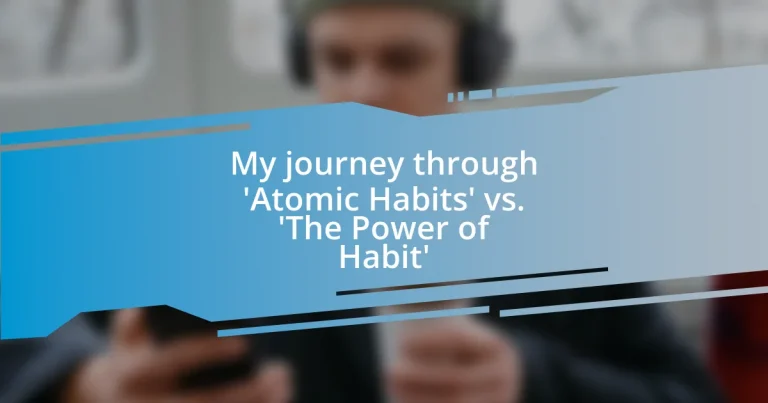Key takeaways:
- Habits consist of a cue, routine, and reward, with emotional connections influencing our behaviors and responses.
- “Atomic Habits” focuses on incremental improvements and identity transformation, while “The Power of Habit” emphasizes understanding the habit loop and emotional triggers.
- Integrating strategies from both books, such as habit stacking and environment design, enhances personal growth and self-awareness through consistent reflection and adjustments.
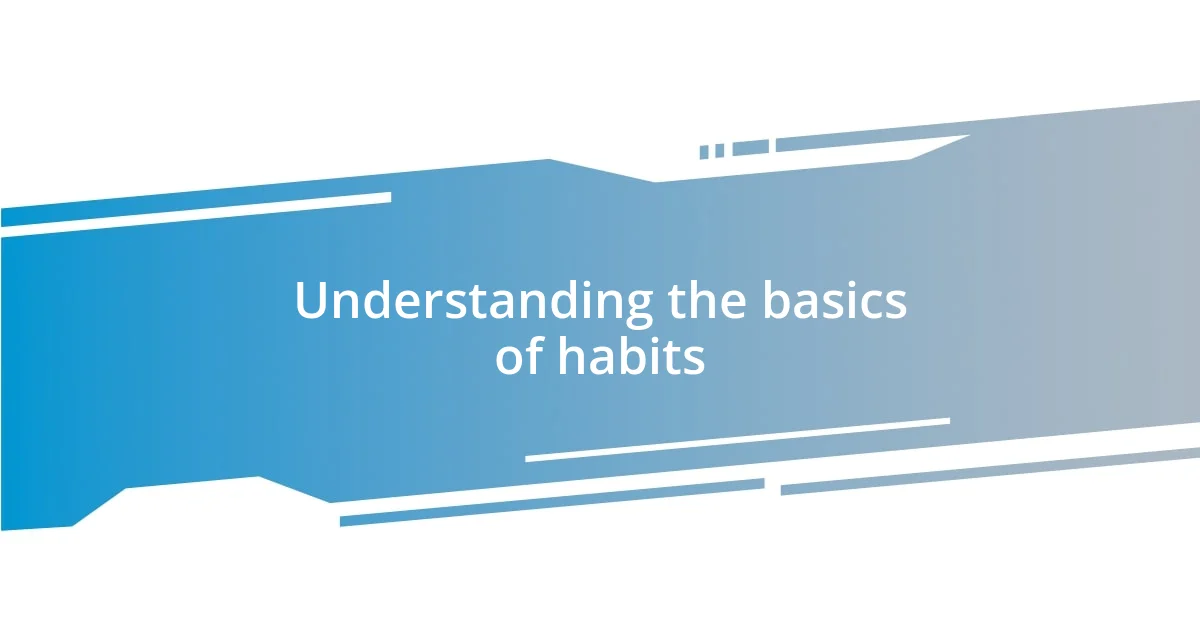
Understanding the basics of habits
Habits are essentially our brain’s way of streamlining actions to save energy. I remember the thrill of learning to ride a bike; it felt awkward at first, but soon enough, it became second nature. Isn’t it fascinating how our brains automate routine behaviors, allowing us to focus on more complex tasks?
At their core, habits consist of a cue, a routine, and a reward. Think about the last time you reached for a snack while watching TV. The cue could be the sight of the television, the routine is grabbing the snack, and the reward is the moment of satisfaction you feel. It’s amazing how these small patterns can create significant changes in our lives.
Emotional connections also play a significant role in habit formation. I often reflect on how certain smells trigger memories, like the aroma of freshly baked cookies taking me back to childhood when my grandmother would bake. Why do we often revert to old habits during times of stress? These emotional ties shape our responses and can either propel us forward or hold us back.

Overview of ‘Atomic Habits’ concepts
In “Atomic Habits,” James Clear offers powerful insights into the process of habit formation and transformation. One key concept is the idea of “1% improvements,” where he emphasizes that making small, incremental changes can lead to significant results over time. I remember when I decided to start exercising regularly; instead of overwhelming myself with a full workout, I simply committed to a 10-minute walk each day. Over time, those small steps accumulated, and I discovered a consistent fitness routine that truly made a difference in my life.
Here are some fundamental concepts that “Atomic Habits” explores:
- The Four Laws of Behavior Change: Clear explains that to build good habits, you must make them obvious, attractive, easy, and satisfying.
- Identity-Based Habits: He emphasizes the importance of focusing on who you want to become rather than just what you want to achieve. This shift can be powerful; when I identified as someone who enjoys reading, I found myself picking up books more often.
- The Habit Loop: Clear illustrates the cue, craving, response, and reward cycle, reinforcing how understanding this loop can help us refine our habits.
- Environment Design: Changing your environment to make good habits easier and bad habits harder is a practical strategy I’ve implemented, like keeping healthy snacks in plain sight.
These concepts not only articulate how habits work but also empower us to take actionable steps toward change.
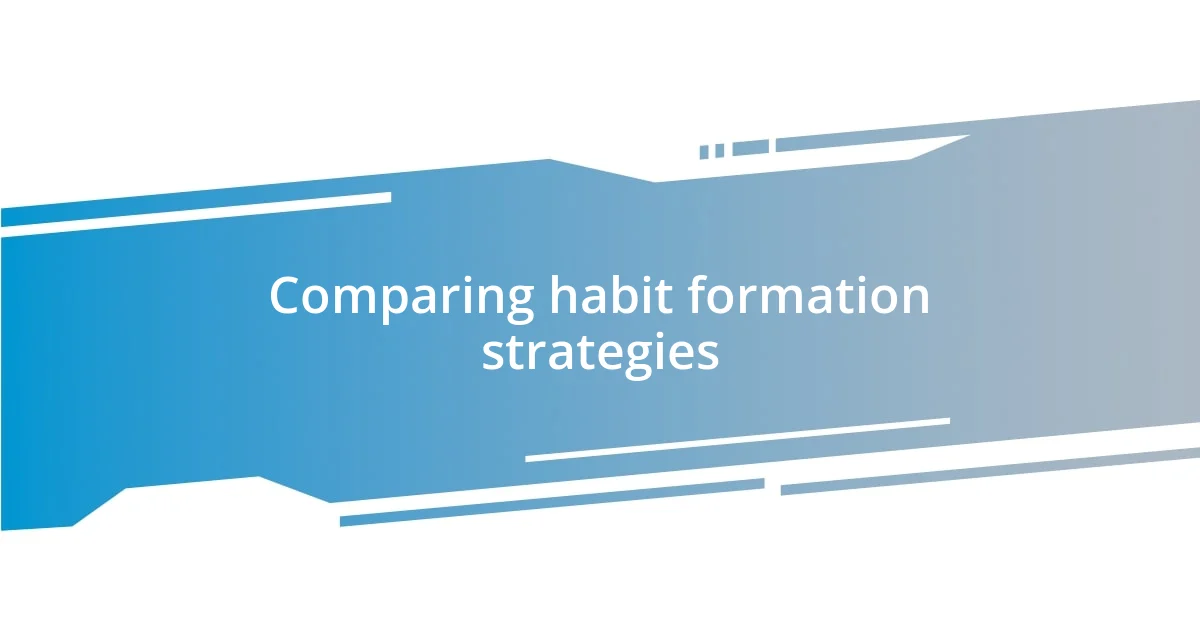
Comparing habit formation strategies
When it comes to habit formation, both “Atomic Habits” and “The Power of Habit” offer unique strategies that resonate with different aspects of our lives. I find “Atomic Habits” particularly appealing because it focuses on making small, manageable changes. For instance, I started meditating for just two minutes each morning, and that simplicity allowed me to gradually increase the time without feeling overwhelmed. On the other hand, “The Power of Habit” emphasizes the habit loop—cue, routine, reward—which I’ve noticed helps clarify my motivations. Reflecting on my own journey, understanding this loop helped me break a bad habit of mindless scrolling on my phone before bed.
The emotional connections we have to our habits cannot be understated. In “Atomic Habits,” the emphasis on identity transformation really resonates with me. It encourages us to envision the person we want to become. I vividly remember shifting my self-image from a “non-runner” to someone who enjoys jogging, which not only motivated my physical activity but also made me more disciplined in other areas of my life. Conversely, “The Power of Habit” explores how understanding our existing emotional triggers can empower us to replace unhealthy habits with positive ones. I’ve personally seen this unfold when I recognized that stress led me to junk food; finding healthier stress-relief methods turned my impulse eating around.
Understanding the differences in these approaches can be eye-opening. “Atomic Habits” emphasizes incremental progress, while “The Power of Habit” offers a more holistic view of habits as systems. It’s similar to how I’ve approached personal development in different areas. As I explored new hobbies, I adopted small goals, but I also reflected on the emotional cues that drove my desire to pursue those hobbies. This dual perspective has been transformational in my journey toward lasting change.
| Aspect | Atomic Habits | The Power of Habit |
|---|---|---|
| Focus | Incremental changes | Understanding habit loop |
| Engagement with identity | Shifts in self-image | Emotional triggers |
| Strategy | Environment design | Habit systems |
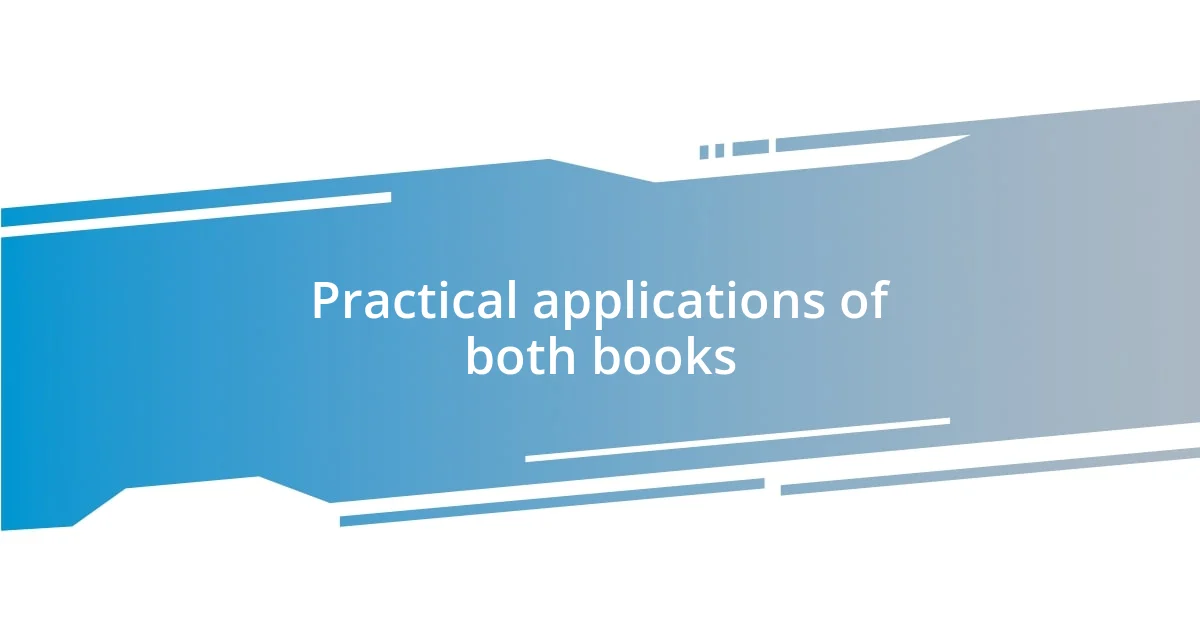
Practical applications of both books
Implementing the lessons from “Atomic Habits” in my daily life has been quite rewarding. For example, I decided to apply the Four Laws of Behavior Change to my writing routine. By leaving my notebook on my desk where I could easily see it, I made writing not only obvious but also appealing. This simple change turned my intention into action, and I soon found myself drafting articles with greater frequency. Isn’t it fascinating how a slight shift in visibility can impact motivation?
On the flip side, “The Power of Habit” has profoundly influenced how I manage my time. After recognizing that my evenings were often consumed by a mindless routine of TV, I identified the cue—feeling tired after a long day—and replaced that unhealthy habit with reading. By reconnecting with the reward of a good story, I found myself embracing evenings filled with literature instead of screen time. Have you ever thought about how a simple switch in your nightly habits could lead to personal growth?
Ultimately, what I cherish about both books is their complementary nature. While “Atomic Habits” champions the notion of gradual improvements, “The Power of Habit” underlines the significance of understanding our mental frameworks. I’ve learned to combine these insights; for instance, I now break down larger aspirations into small, manageable tasks while being aware of the emotional cues driving my behaviors. This balanced perspective has truly enriched my journey, allowing me to cultivate not just better habits but a stronger sense of self-awareness along the way.
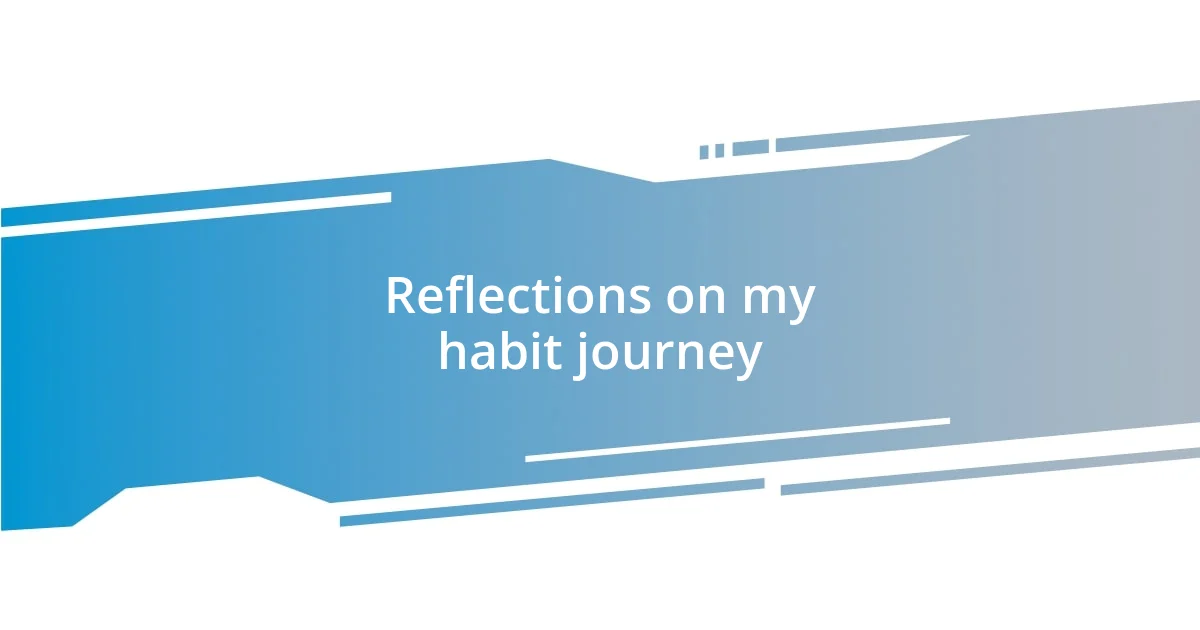
Reflections on my habit journey
Reflecting on my habit journey has been a mixture of revelations and challenges. I remember the early days when I wanted to build a consistent workout routine; it felt almost insurmountable, yet breaking it down into simple, daily ten-minute sessions made it less daunting. Have you ever experienced that moment when what seemed impossible suddenly becomes achievable just by shifting your perspective?
As I delved deeper into the principles of both “Atomic Habits” and “The Power of Habit,” I realized that my habits weren’t just tasks—they were tied to my identity and emotions. There was a time when I struggled with procrastination, and I finally faced the uncomfortable truth: I was avoiding the tasks that made me anxious. Recognizing this, I started to view myself as a “doer” rather than a procrastinator, and that mental shift transformed my approach to even the most daunting projects.
Now, I’ve come to appreciate the intricate dance between my emotional state and my habits. For instance, when I feel overwhelmed, I often default to snacking or scrolling through social media, which I recognized as coping mechanisms. By consciously choosing uplifting activities, like journaling or quick stretches, I’ve created a positive feedback loop. Have you explored the emotional undercurrents of your habits? Understanding these connections has not only made my journey more enriching but has also provided me a roadmap for ongoing personal growth.
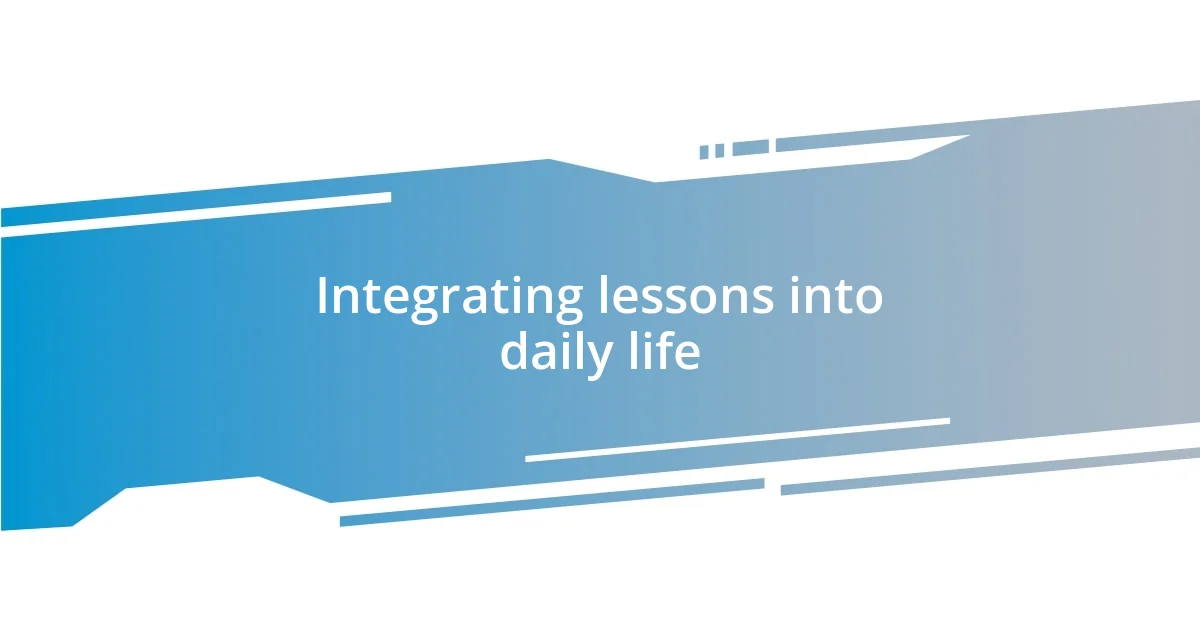
Integrating lessons into daily life
Integrating lessons from “Atomic Habits” and “The Power of Habit” into my daily life has been a transformative experience. I vividly recall how, during a particularly busy week, I struggled to find time for exercise. By simply using a calendar to block off specific times for my workouts, I made it a non-negotiable part of my schedule. Have you ever found that marking things down gives them a sense of importance? It’s like giving wings to your intentions.
One of the most impactful practices I’ve adopted is habit stacking, inspired by “Atomic Habits.” I began pairing my morning coffee with a five-minute meditation session. This simple addition not only enhances my day but also helps establish a sense of calm before diving into my busy schedule. I think back to those chaotic mornings where I rushed without purpose. Do you remember a time when you felt scattered and realized you could anchor your day with a small ritual? It’s astonishing how these minor adjustments can create a ripple effect throughout the day.
As I navigate my routine, I’ve learned that reflection is key to integrating these lessons. Each Sunday, I take a moment to review my week, noting what habits served me well and which ones could use some tweaking. Just yesterday, I acknowledged that my late-night snacking had crept back in. By revisiting my cues, it became clear that I was eating out of boredom rather than hunger. Have you considered how the act of reflection could illuminate your own patterns? This practice not only sharpens my awareness but also helps me realign my actions with my goals, ensuring that I’m always moving forward.












